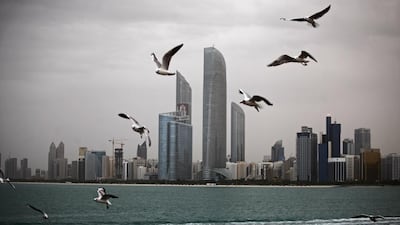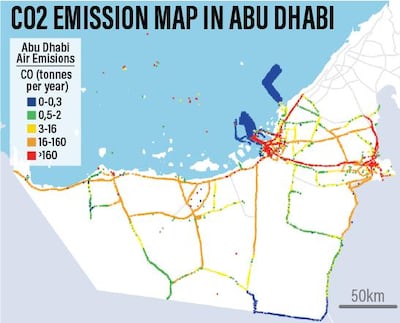A new comprehensive pollution map of Abu Dhabi will allow regulators to crack down on businesses that flout environmental rules.
The first-of-a-kind blueprint, the Abu Dhabi Air Emissions Inventory, was drawn up by experts using satellite imaging, traffic monitoring and submissions from industry.
It gives an in-depth breakdown of six major man-made pollution sources in the city and pinpoints emissions levels in different areas. The maps will give health and environmental authorities a new tool for assessing the effect of pollution on the public and the environment and come up with new policies to manage the risks.
On Wednesday, Oriol Teixido, an air quality scientist at the Abu Dhabi Environment Agency, said the unique map was created with the help of world-leading guidance and technology.
"We know for road transport the emissions of Sheikh Zayed Road, for example, from traffic light to traffic light," he said. "This is the significant level of detail we have reached."
Emissions of nitrogen oxide and carbon monoxide, which are associated with cancer if present in high enough levels, were highest in areas with heavy traffic and industry, such as Mussaffah Industrial Area and Khalifa Industrial Zone. Meanwhile, the highest levels of sulphur dioxide, associated with oil and gas activity, was in Al Dhafra, south of Abu Dhabi city as well as near ports.
The new data will be shared with academics to help with research.
Abu Dhabi has a target of recording 90 per cent "green days", meaning no pollutant exceeds target levels, by 2021. The present total is about 78 per cent, The National has learnt.
Shaikha Al Hosani, executive director of environmental quality at EAD, said "further stringent regulations" would target the sectors most responsible for pollution.
______________
Read more:
Abu Dhabi endorses app that monitors air quality
UAE needs 'toxicity tax' on high polluting vehicles, industry head says
Measures to improve UAE air quality enacted
______________
"We will focus on the power plants, steel industry and the cement industry, given it produces a lot of dust as well," she said. "The focus … is to monitor the effectiveness of the existing regulations, and recommend a plan for the coming regulations that we will endorse.
"Of course, enforcement is one of the main actions … when it comes to those who break rules, it will start with a dialogue about what they are doing right and what they are doing wrong. We will give them the time to take action to correct it. If they were doing it out of ignorance, we will give them the time, if they are doing the same mistake we take action.
"That action will be warnings, if they don't respond it will escalate to court. [The fines] range from Dh10,000 to sometimes Dh300,000 based on the impact of the breach.
“The results of the Air Emissions Inventory have laid a solid groundwork for us to pursue targeted mitigation measures in co-operation with our public and private sector partners, which in turn will improve the environment and the lives of people living in Abu Dhabi’s rural and urban areas.”
There are more than 50 sector and pollutant-specific maps of Abu Dhabi.


